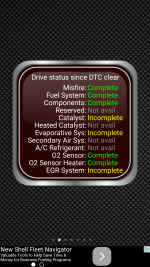Whenever you remove the battery (unless you plug in the charger first) or clear a "Check Engine" light code, the emissions readiness tests must be run again. The monitors check for presence and operation of critical engine emissions systems, e.g., O2 sensors, catalytic converter, EGR system, etc.
Running the diagnostics require some specific sequences be run in order to declare the tests completed.
This question comes up frequently, and the answers are often buried in a response that contains a link. My link in one of those topics no longer works, so I have copied and will post as reply #1 the sequence as copied from the 2006 Ford GT service manual (CD).
The sequence is actually common to all of the Ford V8s that I have owned in the past.
In order to determine the progress of these tests it is necessary to have an OBDII reader. Some "tuners" that read engine codes will show after the code or battery reset the P1000 pending check code which means that the reset test is in progress. Many will not expose the details. But a Bluetooth OBDII reader combined with an app on your favorite phone or tablet will show you the status of the monitors. It will look something like this:

My recommendation for clearing the tests is to take a short drive of 10-15 miles. Many, maybe even all, of them will complete. Then use the specific drive cycle instructions for the incomplete ones to finish off the sequence. My recollection is that some of the tests complete almost immediately, e.g., misfire, and that the catalyst test in my case was the most difficult. The Evap system has some temp requirements too that were difficult to meet in the hot summer of Vegas. The Evap test is the item that drives the fuel tank level of 3/4 full. It won't run unless it is within the range.
As I said in another post, some of the specific sequences require a section of road that allows for reasonable travel followed by some stops (that hardly every coincide with a stop light, or pulling off to the side of the road).
Until I found this sequence it would take 100 miles to run everything over a few days. Once I found the sequence I could do the quick drive to check off the simple ones and check the remaining ones in another 20 miles or so.
Enjoy!!!
PS. the cycle doc is full of TLAs (three letter acronyms). Part of the test to be able to use this document is to know what those abbreviations mean
Running the diagnostics require some specific sequences be run in order to declare the tests completed.
This question comes up frequently, and the answers are often buried in a response that contains a link. My link in one of those topics no longer works, so I have copied and will post as reply #1 the sequence as copied from the 2006 Ford GT service manual (CD).
The sequence is actually common to all of the Ford V8s that I have owned in the past.
In order to determine the progress of these tests it is necessary to have an OBDII reader. Some "tuners" that read engine codes will show after the code or battery reset the P1000 pending check code which means that the reset test is in progress. Many will not expose the details. But a Bluetooth OBDII reader combined with an app on your favorite phone or tablet will show you the status of the monitors. It will look something like this:

My recommendation for clearing the tests is to take a short drive of 10-15 miles. Many, maybe even all, of them will complete. Then use the specific drive cycle instructions for the incomplete ones to finish off the sequence. My recollection is that some of the tests complete almost immediately, e.g., misfire, and that the catalyst test in my case was the most difficult. The Evap system has some temp requirements too that were difficult to meet in the hot summer of Vegas. The Evap test is the item that drives the fuel tank level of 3/4 full. It won't run unless it is within the range.
As I said in another post, some of the specific sequences require a section of road that allows for reasonable travel followed by some stops (that hardly every coincide with a stop light, or pulling off to the side of the road).
Until I found this sequence it would take 100 miles to run everything over a few days. Once I found the sequence I could do the quick drive to check off the simple ones and check the remaining ones in another 20 miles or so.
Enjoy!!!
PS. the cycle doc is full of TLAs (three letter acronyms). Part of the test to be able to use this document is to know what those abbreviations mean
Last edited:

